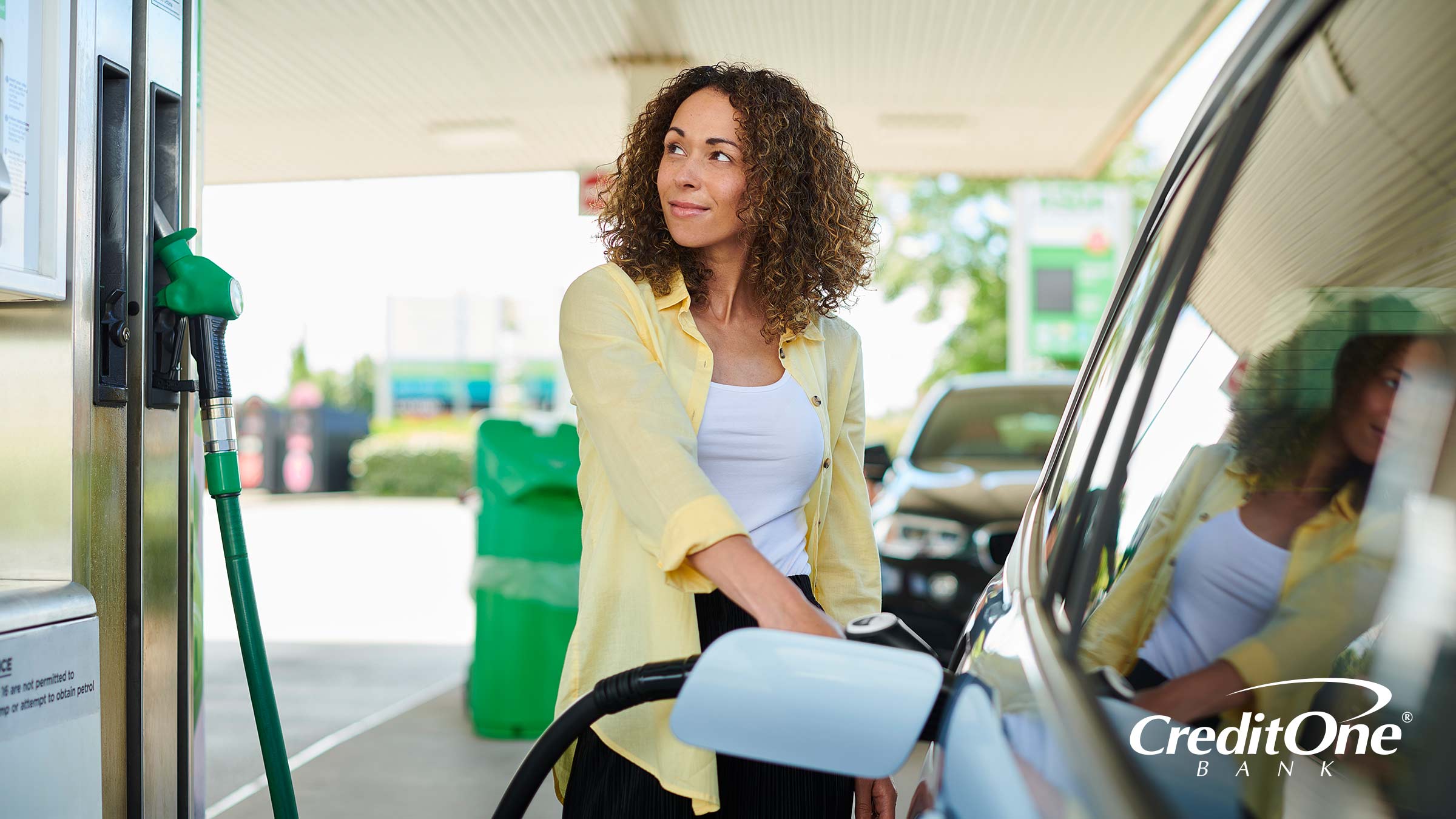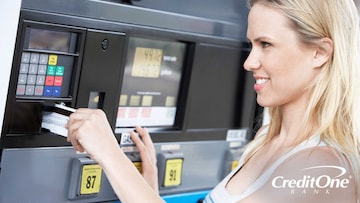12 Tips for Combating Record High Gas Prices
March 28, 2022
Topics:
Saving MoneyGas prices are at an all-time high, but there are a few things you can do to help minimize the pain you feel at the pump.

It’s official—as of the writing of this article, the average price of a gallon of gas in the United States has reached an all-time high. This is on top of inflation reaching a 40-year high and supply-chain and labor issues from the coronavirus pandemic still lingering.
Unless you have an electric car or can navigate your life without a gas- or diesel-powered vehicle, you’re undoubtedly feeling a pinch at the pump every time you fill up. But there are a few things you can do to make the pain a bit less excruciating besides just closing your eyes and ignoring the “This Sale” numbers as they climb toward triple digits every time you fill up.
TIPS FOR SAVING AT THE PUMP
1. Take advantage of credit card rewards. If the cash and credit prices for gas are equal at a filling station, using a rewards credit card to fill up your tank could help offset the cost of your gas purchase. If it’s a cash back rewards card, and gasoline is an eligible purchase that earns you cash back rewards, those rewards would typically be redeemed each month as a statement credit, which means you use less of your own money to pay off your credit card bill. If your rewards card earns you points or travel miles, when you redeem those points or miles for merchandise, travel, or more, that’s money you’re saving that can be applied toward gasoline purchases instead.
2. Take advantage of cash discounts. If a filling station offers a discount for using cash instead of credit, then cash is likely a better option than a credit card—in some cases even if it’s a rewards credit card. You’ll have to do some quick math at the pump to figure out which is the more rewarding payment method. If, for example, the station offers a 5 percent cash discount on gas and your cash back rewards card offers 3 percent cash back rewards, then you’ll save money (2 percent) by paying for your fill-up with cash.
3. Pay attention to prices. While you’re out driving, try to notice the prices charged at various filling stations around town and make a mental note of where gas is cheapest. Don’t waste gas driving around looking for cheaper gas; just keep your eyes peeled while you’re commuting or out running errands. If you find a cheaper station, and it’s not out of your way, fill up there the next time you need gas.
Also, pay attention to your local news broadcast. Many channels run regular segments highlighting where to get the cheapest gas in town, typically based on feedback from viewers.
4. Consider using a gas app. Certain apps, like GasBuddy, can help you find the cheapest gasoline in your area. Other apps, such as GetUpside, claim to earn you cash back on gasoline purchases. Just be sure to do some research and read reviews to make sure the app is legit and does what it says it does before downloading it.
5. Fill up on Mondays or Fridays. A 2021 study by GasBuddy found that Monday is the best (cheapest) day of the week to buy gasoline and Friday is the second best. That same study estimated that a driver could save between $50 and $100 per year simply by filling their tank on either of these days.
TIPS FOR SAVING ON THE ROAD
1. Walk, run, or roll to where you’re going. This suggestion is obviously not an option for every trip you make, but for many of us, there are opportunities to walk or ride a bike or even skate to where we’re going instead of driving. So, while it may not be possible for you to ride your bicycle in to work, walking up to the corner store instead of driving may be extremely doable and a good opportunity to get some fresh air and exercise at the same time. Or, say that your gym is a mile from your home. Why not briskly walk or jog to the gym instead of driving? Doing so allows you to save gas and eliminate the need to do cardio on the treadmill to warm up once you get there.
2. Combine errands that require driving. Rather than run to the hardware store, come all the way home, and then make a separate trip to the grocery store later, which happens to be on the way home from the hardware store, why not take care of both errands in one trip? You’ll save gas and another equally precious commodity: your time.
3. Carpool when you can. Joining a carpool is a great way to cut back on gasoline consumption, and it’s good for the environment. Of course, it’s not an option for everyone or every trip you take, but if your neighbor works for the same company at the same facility and they’re on the same schedule as you, why not ride in together, enjoy their company, and save on gasoline?
Chauffeuring kids around to their various activities is another good opportunity to implement a carpool. You’ll save money on gas and free up time spent dropping off and picking up your kids.
4. Improve your driving habits. Jackrabbit starts, revving your engine at stoplights, charging stop signs, and braking to slow down when simply removing your foot from the accelerator pedal will suffice are all surefire ways to waste gasoline. According to the U.S. Department of Energy, driving aggressively can lower gas mileage 15 to 30 percent at highway speeds and up to 40 percent in stop-and-go traffic. So, to get better mileage from each precious gallon of gas, drive smarter, which also happens to be safer.
5. Drive in “Eco” mode. Many newer cars come equipped with an Eco driving mode, which sacrifices a bit of a vehicle’s performance to help improve gas mileage. How much Eco mode improves a vehicle’s gas mileage varies by manufacturer, but cartreaments.com estimates it improves mileage by roughly five percent, which translates to about $10 per month in gas savings if you spend $200 per month on gas.
But there’s a caveat. If you’re driving in rush-hour traffic, or any other situation where you may need to accelerate quickly and require all of your vehicle’s performance, you should probably switch out of Eco mode and perhaps even into Sport mode. Staying safe in challenging driving situations always trumps getting better gas mileage.
6. Maintain your vehicle to be more fuel-efficient. Unless you’re mechanically inclined, this tip could set you back some money up front but should end up paying for itself in improved mileage and by keeping your car in service longer.
According to safemotorist.com, a tune-up can save you an average of 4 percent on gasoline, using the manufacturer-recommended motor oil type can improve gas mileage by 2 percent, and replacing a dirty air filter could improve gas mileage by up to 10 percent. Even keeping your tires properly inflated makes a difference. The U.S. Department of Energy found that properly inflated tires increase gas mileage by an average of .6 percent and up to 3 percent in some cases.
7. Stop using premium fuel if your vehicle doesn’t require it. If your vehicle’s owner’s manual recommends regular-grade gasoline and you’re filling it with mid-grade or premium-grade fuel, you are spending extra money for no real gain.
Back in 2016, a AAA study found that American drivers wasted $2.1 billion buying premium-grade gas instead of regular-grade, with no real benefit other than feeling like they were treating their cars better. So, unless your user manual specifically states that your vehicle requires a higher grade of gasoline than regular, don’t hit the premium-grade button at the pump. Regular should suffice and could save you around $0.50 per gallon.
TIPS THAT APPEAR TO BE MYTHS (AS IN, DON’T BOTHER):
1. Gas additives. While there’s a whole array of them in every auto-parts store and in the automotive section of big-box stores, there’s no compelling evidence that fuel additives help increase gas mileage—with the possible exception of if you’re using the wrong octane-rated fuel required for your car and the additive boosts the fuel up to where it should be in the first place.
Fuel additives may help clean fuel injectors and fuel lines and prevent future maintenance issues, but don’t expect to save any significant money on gasoline by adding a can to your tank every few thousand miles.
2. Fill up during the coolest part of the day. Colder gasoline is denser than warm gasoline, so it seems logical that putting colder gas into your tank during the coolest part of the day would result in more gas in your tank, right?
Given that most gasoline tanks at filling stations are underground, the time of day you fill up doesn’t appear to save you any significant money. Consumer Reports found that even a 15-degree difference in temperature resulted in about a one percent gain in gasoline volume, which equated to savings of only a few cents. Hardly enough savings to justify getting up early to fill your tank before the sun warms up your local filling station.
It looks like higher gas prices are here to stay for the foreseeable future. While no one tip will offset the hefty increases we’ve all experienced in a short amount of time, saving a percentage here and there by being more strategic and changing some of our driving habits may be about as good as we can hope for—at least until things settle down. Until then, every little bit helps.
After realizing he couldn’t pay back his outrageous film school student loans with rejection notices from Hollywood studios, Sean focused his screenwriting skills on scripting corporate videos. Videos led to marketing communications, which led to articles and, before he knew it, Sean was making a living as a writer. He continues to do so today by leveraging his expertise in credit, financial planning, wealth-building, and living your best life for Credit One Bank.



![How a Cash Back Credit Card Works [Infographic]](/content/dam/cob-corp-acquisition/images/articles/2020/09/prs1115_Cash Back Rewards Credit Card Header_FINAL.png?imwidth=360)